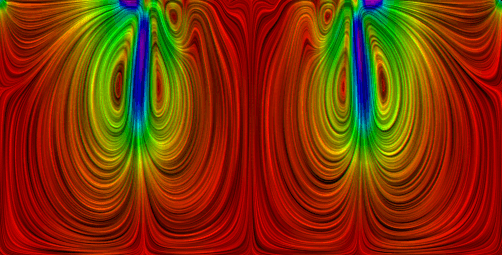Call via File  Export
Export  Schlieren illustration
Schlieren illustration
The program FLIC (Konrad-Zuse-Centre for Information Technology Berlin) can visualize the velocities computed in a flow calculation by the help of Schlieren. The underlying method is called "Line Integral Convolution (LIC)". This visualization provides a much better image of flow paths than the velocity arrows used in the plot generation. This is especially important for transient and 3D models where a streamline calculation is not possible.

The data export creates an ASCII input file with the computed velocities for the FLIC program. The ASCII interface to the program FLIC is based on grid data. That's why the computed velocities must be determined at grid nodes beforehand. Additionally, it is possible to colour the Schlieren by using values from the input or the resulting data which exist at every node or element. These values (i.e. concentrations) are stored in an ASCII file. Markings are issued as a possible overlay file (*.mar).
Calling FLIC is done automatically during the export of data or can be started manually from a terminal on the command line:
FLIC then generates a bitmap image in jpg format, which can be read using a suitable graphics program. In 2D horizontal models and horizontal sections of 3D models the corresponding world file (extension *. jgw) is also created with the information required for georeferencing. Below the FLIC commands are listed, which can also be entered directly into the command line.
cmd=<filename> read more commands from a file
field=circle use a circular vector field
field=spiral use a spiral-type vector field (default)
field=<filename> read a vector field from a file
out=<filename> name of the resulting LIC image (required)
size=<nx>x<ny> size of noise input image (default 256x256)
in=bwnoise create black-white noise image
in=colornoise create color noise image
in=<filename> use given image file as input
resize=<nx>x<ny> resize current input image
kernel=box select box filter kernel
kernel=triangle select triangle-shaped filter kernel (default)
kernel=cubic select third-order B-spline filter kernel
length=<n> length of filter kernel in pixels (default=20)
subpix=<n> enable nxn super-sampling to reduce aliasing
contrast=raw no contrast adjustment (default for file input)
contrast=auto contrast adjustment (default for noise input)
enhance=0 disable post-filtering of LIC image (default)
enhance=sharpen compute directional derivative of LIC image
enhance=emboss,<a> apply emboss filter, angle arg is optional
integrator=euler use Euler method for field integration
integrator=rk43 use adaptive Runge-Kutta integrator
interpol=const nearest-neighbour interpolation of input image
interpol=bilinear bilinear interpolation of input input (default)
colorfield=dir color denotes vector orientation (fixed colormap)
colorfield=mag compute color from vector field magnitude
colorfield=<file> compute color from scalar field stored in file
colormap=hueramp use hueramp for pseudocoloring
colormap=hotiron use rot-yellow-white colormap
colormap=<file> read colormap from file (icol format)
colorrange=auto colormap min max adapted to colorfield (default)
colorrange=min,max specifies colormap min max values
overlay=<file> render graphics on top of output image
verbose=0|1 enable verbose mode (default is off)
